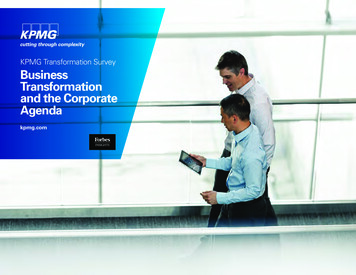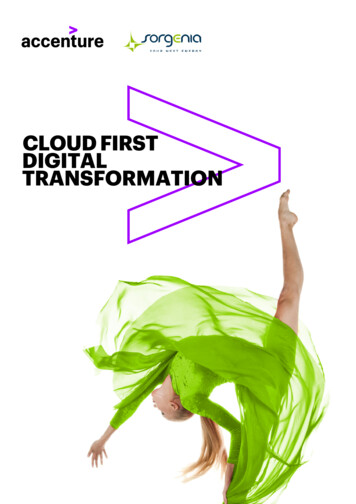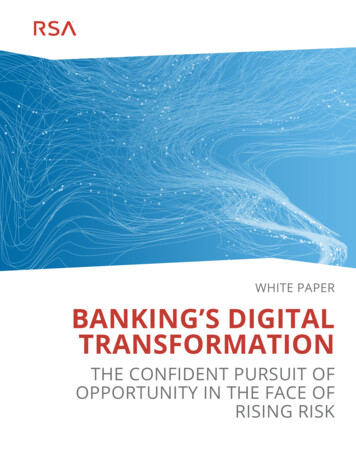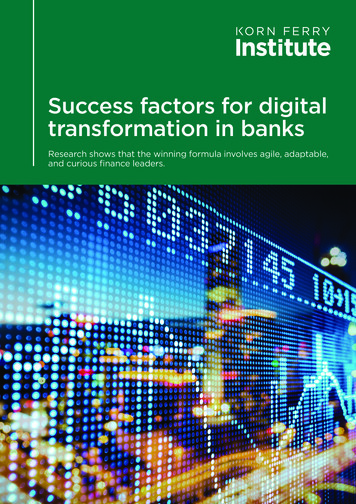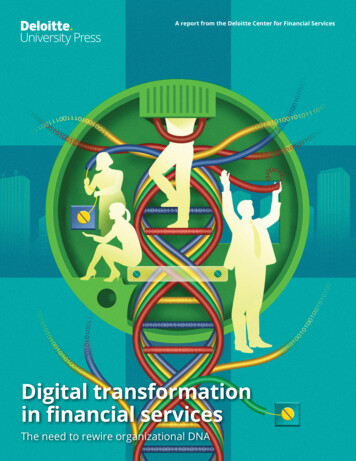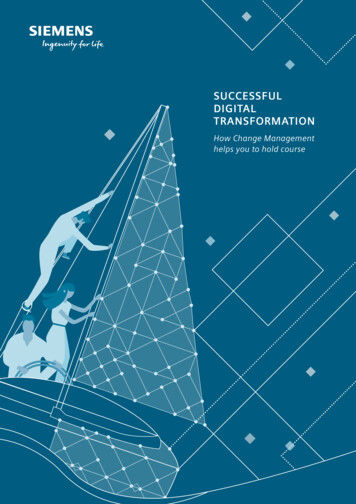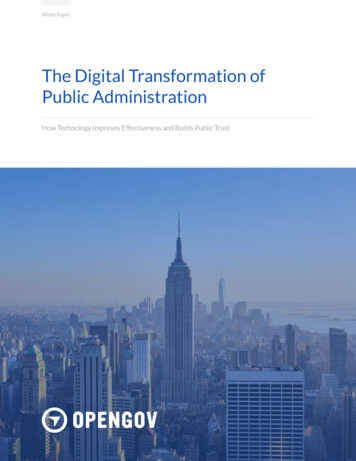
Transcription
White PaperThe Digital Transformation ofPublic AdministrationHow Technology Improves Effectiveness and Builds Public Trust
Competent administration fuels effective government. Scholars and governmentleaders have spent decades developing best practices in public administration;nevertheless, the ideas are sometimes impossible to implement. Manygovernments struggle to plan and build budgets, to make informed, datadriven decisions, and to communicate meaningfully with all stakeholders forincreased transparency. While public administrators strive to serve citizens assuccessfully as possible, outdated government technology impedes effective andaccountable administration.In this guide, you’ll learn how you can strengthen budgeting, improve operationalperformance through enhanced reporting and analysis, and communicate clearlyto engage the public and demonstrate your success — all by connecting yourgovernment with the right technology. These processes all facilitate more efficient,effective government administration.This is government — and information — in action.2
Contents4Introduction7A Unique Moment in History13Budgeting in the Smart Government Era20Performance Management in the Smart Government Era25Open Data in the Smart Government Era28Conclusion: The Smart Government
Introduction“Administration is the most obvious part of government; it is government inaction; it is the executive, the operative, the most visible side of government, andis of course as old as government itself.” -Woodrow Wilson1Effective administration accomplishes wonders.In January 1858, the Chicago Tribune said the project “excited the publiccuriosity.”2 But the crowd that watched workers raise a four-story brickhouse six feet off the ground saw more than a curiosity — the crowd sawan effort that slashed commute times, liberated women from carryingchamber pots to the river, and saved thousands of lives from the scourgesof cholera and dysentery. Citizens saw the initial steps toward finishingAmerica’s first comprehensive sewer system.Nineteenth-century Chicago was only a few feet above Lake Michigan,so water seeped into the dirt when rain fell. In turn, commuterslanguished in muddy streets. The mud accumulated human waste andravaged Chicago with disease — cholera killed five percent of the city’spopulation in 1854 alone.3The newly-created Board of Sewer Commissioners decided to build asewage system to fix the problem. But because Chicago’s buildings weretoo low, engineers had to raise almost every building and street several1Wilson, Woodrow. “The Study of Administration.” Political Science Quarterly, Vol. 2, No. 2. http://www.iupui.edu/ spea1/V502/Orosz/Units/Sections/u1s5/Woodrow Wilson Study of Administration 1887 jstor.pdf.June 1887.2“The Lifting of Chicago.” Chicago Tribune. http://users.ox.ac.uk/ sedm1912/csc.html#y1858 m01 d26.July 12, 1854.3Hrala, Josh. “The Raising of Chicago Meant Literally Raising an Entire City Ten Feet.” Modern Notion.November 19, 2014.4
Workers raise the Briggs House in Chicago.feet off the ground without disrupting city life. The government pooled itsmoney with private funds, elevated the city, and built the system.We need similar effectiveness today. The American Society of CivilEngineers estimates governments requires an additional 2.0 trillion torepair, replace, and upgrade crumbling infrastructure over the next decade.4While fiscal pressures mount on all levels, priorities like public safety,social services, and quality education remain as pressing and urgent as ever,forcing local governments to do more with less.America’s public institutions must solve major problems through smartpolicymaking and efficient administration. Today, running a governmentto meet modern challenges naturally requires the most modern software.Unfortunately, many agencies lack the technology necessary to implement4“2017 Infrastructure Report Card: A Comprehensive Assessment of America’s Infrastructure.”Amereican Society of Civil Engineers. df5
effective solutions. Technology innovations have transformed otherareas of our lives: cloud computing and data science let us shop from ourliving rooms, predict consumer behavior, and find love with a swipe on asmartphone. Yet often, public sector agencies have not benefitted fromsimilar transformational technology advances.Fortunately, government leaders are catching up and beginning to leveragemodern technology to implement administrative best practices easily.Increasingly, vendors are building and hosting government-specificplatforms that integrate with and enhance existing tools. Better technologyimproves public administration. Better administration improves citizens’lives. And better quality of life improves trust in government institutions.In this guide, you will learn how modern technology improves threepillars of public administration: budgeting, performance management,and open data. Get these three right, and the odds of successful policyimplementation and development increase exponentially.Although this guide makes distinctions between budgeting, reporting,and open data, modern software integrates all three functions to reflecttheir natural linkages and dependencies. As the Government FinanceOfficers Association (GFOA) describes in Recommended Budget Practices: AFramework for Improved State and Local Government Budgeting, governmentsbuild budgets, report on performance, adjust as necessary, and shareresults with citizens throughout the year.5 These processes drivegovernment effectiveness and accountability across all stakeholders.5National Advisory Council on State and Local Budgeting. “Recommended Budget Practices: AFramework for Improved State and Local Government Budgeting.” Government Finance Officers Association.Page 38. http://gfoa.org/sites/default/ les/RecommendedBudgetPractices.pdf. 1998.6
A Unique Moment in HistoryThe history of public administration featurestwo key paths: 1) advances in best practices and2) advances in the technologies that implementthem. These paths should evolve in concert,but for the past several decades, the former hassurged past the latter.Public Administration TechniquesMarch ForwardFor most of history, few scholars had rigorouslystudied how to run governments. Academicsfocused on political philosophy instead: Where isthe legitimate source of political authority? WhatAlexander Hamilton was critical toadvancing public administration inAmerica.are the states’ rightful prerogatives? Which rightsshould the people retain?This began to change by the end of the 18th century: In America, Secretary of the Treasury Alexander Hamilton enacted aseries of successful administrative reforms during the 1790s. In Europe, Napoléon Bonaparte improved French administration in1803 when he began consolidating expenditures to mimic his Britishrivals. France had a universal accounting system, a standard fiscal year,and written budget documents by the 1860s.It was not until the 1880s, however, that public administration as a socialscience emerged. In a famous 1887 essay, “The Study of Administration,”7
future American President Woodrow Wilson argued the importanceof studying and developing best practices for administration indemocratic societies:“There is scarcely a single duty of government which was once simplewhich is not now complex; government once had but a few masters; it nowhas scores of masters. Majorities formerly only underwent government;they now conduct government. Where government once might follow thewhims of a court, it must now follow the views of a nation.”6Public administration soon emerged as an academic discipline, catalyzingreforms throughout the 20th century. The Council-Manager form ofgovernment, designed to bifurcate politics from administration as much aswas reasonable, spread across America.Cities and counties adopted better budget and audit procedures, rooted outendemic corruption by weakening powerful political machine bosses, andupgraded their management systems.Today, academic institutions combine with organizations such as theInternational City/County Management Association (ICMA) to offer bestpractices, governing paradigms, and insights.Technology Falls BehindGovernments once sat on the cutting edge of technology and were theenvy of American businesses. Few advancements in public administrationwould have been possible without innovations such as the printing press,electricity, calculators, and personal computers. These improvements6Wilson, Woodrow. “The Study of Administration.”8
enabled leaps in public finance and services, such as municipal bondmarkets, civil service systems, and stricter audit standards.As experts increasingly emphasized collaborative budgeting to increaseinvolvement across the organization and data-driven decision-making,technology failed to keep pace. Now, many governments face technicalbarriers that inhibit effective administration: Scattered data. Information is strewn across departments anddifferent systems. Managers need a comprehensive source of reliableinformation to make informed decisions. Such limits inhibit offeringofficials confident, informed insights. Rigid financial and budgeting systems. Although every accountingsystem logs transactions, when it comes to creating and sharingreports essential for management, most fall short. Some financialsystems have reporting tools, but they are often too cumbersome formanagers to use. It is no wonder analysts and finance directors oftenfind themselves manually entering data into spreadsheets to preparereports, answer questions, and even build budgets. Spreadsheets andlegacy systems are often misaligned with the functions for whichpublic sector teams use them. The result is often unwieldy processes,increased errors, limited collaboration, and frustration. On-premise software. On-premise software requires expensive ITmaintenance, quickly becomes outdated, and makes it tough to accessinformation across departments and away from the office.“A government should evaluate its financial performance relative tothe adopted budget.”GFOA, Recommended Budget Practices: A Framework for Improved State andLocal Government Budgeting9
Examples of the gap between best practice and technological possibilityabound. In GFOA’s Recommended Budget Practices: A Framework for ImprovedState and Local Government Budgeting, Practice 11.2 says, “A governmentshould evaluate its financial performance relative to the adopted budget.”7GFOA then explains why this practice supports effective governance:“Regular monitoring of budgetary performance provides an early warningof potential problems and gives decision-makers time to consider actionsthat may be needed if major deviations in budget-to-actual results becomeevident. It is also an essential input in demonstrating accountability.”8Many governments struggle to implement this practice. For example, inAllegheny County, Pennsylvania, a legacy financial management systemmade applying GFOA’s best practices largely unfeasible. Inadequatereporting infrastructure burdened overworked IT staff, already busywith a barrage of information requests from other departments andthe public. Most staff and managers found the financial system toocomplicated to use themselves.Inadequate reporting infrastructure routinely forced departments towait months before receiving expense and revenue packets. Althoughaccountants entered the data on time, there was a delay until they couldreconcile the numbers.Tony Cholewinski, an assistant to Allegheny’s Deputy Controller, asks,“What good is a report on May’s activities if I get it in September?” He adds,“Data delayed is data useless.” Allegheny County’s team addressed theproblem by introducing a web-based reporting solution that made its data7Government Finance Officers Association. “Recommended Budget Practices ”8Ibid.10
“Data delayed is data useless.”Tony CholewinskiAssistant to the Deputy Controller, Allegheny County, Pennsylvaniaavailable on-demand in an easy-to-use format.9 And it was not alone: atOpenGov, we speak with thousands of public sector agencies — from smalltowns and counties to special districts to states — facing similar challenges.Government Technology Catches UpNew technology trends have finally closed the gap between bestpractice and technology.Cloud Computing and Software-as-a-Service (SaaS)Cloud computing is a common theme in discussions around smartgovernment today. Historically, governments used on-premise technologysolutions, tying staff to the office and limiting access to data. Cloudbased software, however, eliminates machine-specific installations and9“Allegheny County, PA Streamlines Management Reporting with OpenGov.” OpenGov. streamlines-management-reporting-with-opengov11
manual software updates by providing online data centers with far greatercomputer power and storage capacity.Software-as-a-Service (SaaS) is delivered in the cloud and gives agencieson-demand access to software through a web browser. Consequently, thesoftware always has the latest enhancements. Cloud-based systems arenot only more cost-effective than traditional software solutions, but theyalso improve internal operations by freeing up time spent on updates,synchronization, constant maintenance, and IT headaches.Special Applications for GovernmentThe transition to SaaS has a long way to go. For example, 50 percent ofcounties still have less than a tenth of their systems in the cloud.10 Butthe tide is turning. SaaS vendors dedicated to governments’ needs, suchas OpenGov, build software designed for public sector use. Companies inSilicon Valley and elsewhere helped create the emerging GovTech industryto meet governments’ unique needs with cutting-edge technology.The Smart GovernmentAt OpenGov, we believe we are entering the Era of Smart Government,where agenc
advancing public administration in America. 8 future American President Woodrow Wilson argued the importance of studying and developing best practices for administration in democratic societies: “There is scarcely a single duty of government which was once simple which is not now complex; government once had but a few masters; it now has scores of masters. Majorities formerly only
